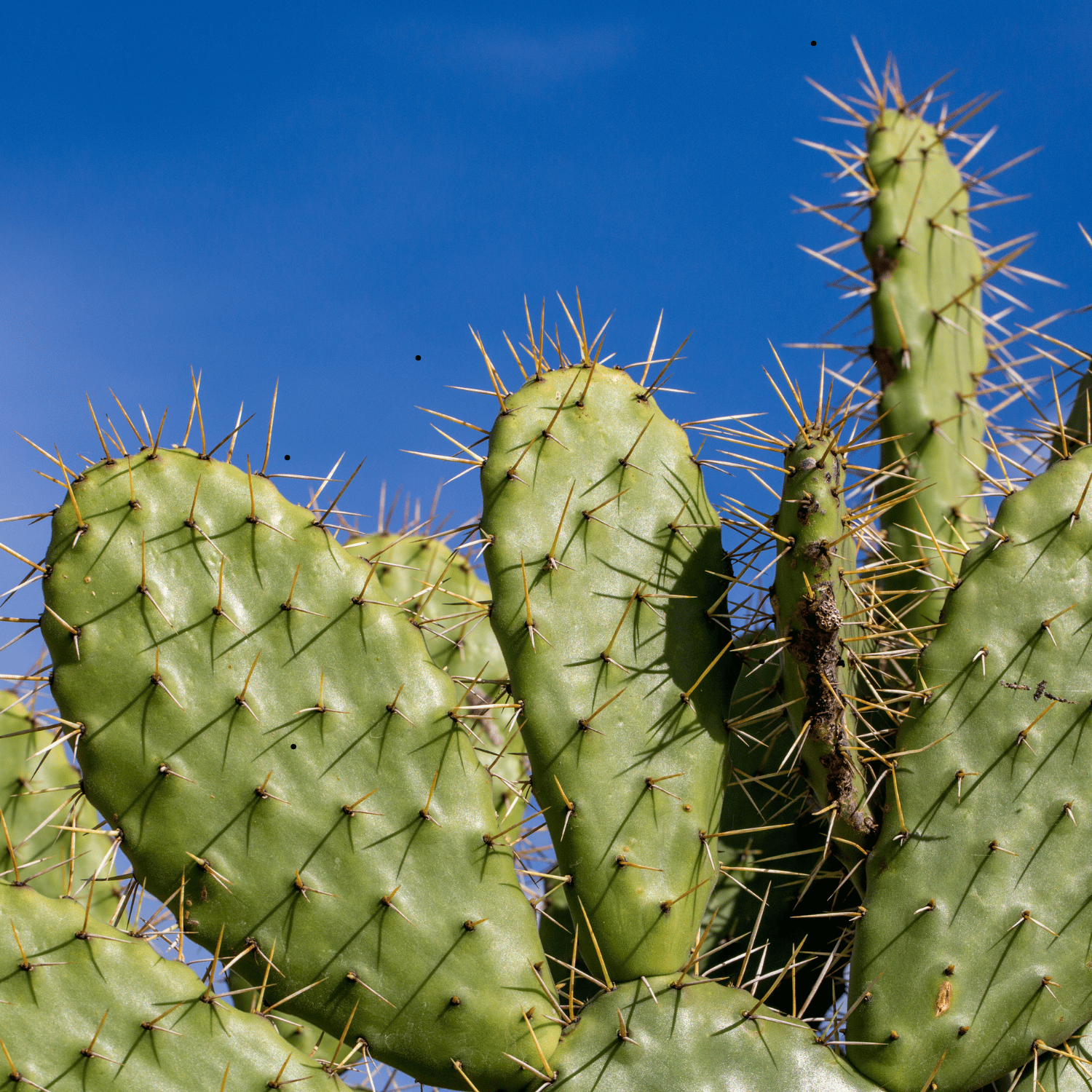
The Wonders of the Nopal Cactus
Nopal Cactus (Opuntia ficus-indica)
The nopal cactus (commonly known as the prickly pear or its scientific name Opuntia) belongs to the cactus family. This specific cactus plant is widely found in Mexico, Latin America, South Africa and Mediterranean countries; it’s a staple food in those regions, with the edible parts being the leaves, flowers, stems and fruit. Prickly pear cactus can be eaten whole (boiled or grilled) or even made into juice and jam spreads
There has been a lot of research In recent decades for the many beneficial health properties of this high in fibre superfood. Nopal cactus contains a wealth of health attributes, such as:
-
niacin
-
riboflavin
-
vitamin B6
-
copper
-
iron
-
fibre
-
vitamin C
-
vitamin K
-
calcium
-
potassium
-
magnesium
-
manganese, Among others
Notably, it’s rich in polyphenols, vitamins, polyunsaturated fatty acids and amino acids.
Benefits of Nopal Cactus
Nopal cactus provides a variety of nutritional and health benefits:
Antiviral – evident against Herpes simplex virus (HSV), Respiratory Syncytial Virus (RSV), HIV
Neuroprotective – protects nerve cell against damages that can cause sensory loss and pain
Antioxidants – reduces oxidative stress, prevents free radical’s formation and free against many diseases
Diabetes – regulate blood sugar levels
Treat enlarged prostates – enlarged prostates is a condition that leads to increase in urination frequency
Reduce cholesterol – studies show lowered LDL cholesterol, which is also known as the bad cholesterol.
Improves skin – antioxidant properties reduce ageing and helps with clearer skin
Nopal cactus are potential metabolic regulators - meaning that cactus extracts have beneficial effects on the metabolisms of both lipid and glucose, which could aid in the treatment of metabolic disorders including diabetes and obesity. On the other hand, the antioxidant and anti-inflammatory properties of cactus pear have polyphenols and flavonoids, which are proven to prevent against several age-linked diseases.
Nopal Cactus and Diabetes
Many studies have been conducted to prove the functionality of nopal cactus in regulating blood sugar levels. In one study, extracts of the cactus plant seeds increased muscle and liver glycogen and reduced blood glucose levels in diabetic rats, demonstrating possibility of insulin-sensitizing effect.
In 2007, a study done by Diabetes care showed that blood sugar reduced by up to 48% after including prickly pear in their meals. A prior study conducted on an extract of prickly pear cactus showed significant improvements in metabolic syndrome, a condition characterized by central obesity, hypertension, and disturbed glucose and insulin metabolism. The syndrome has been linked to increased risks of both type-2 diabetes and Cardiovascular diseases
Cactus pear has also been found to decrease postprandial hyperglycaemia (60 min after glucose loading), 40.33% and 16.01%, in healthy and diabetic glucose-loaded rats, respectively. Cactus pear, also, significantly decreased intestinal glucose absorption by 25.42%.
Although proven to be very potent, consumption should be taken with consideration as nopals can sometimes make people hypoglycaemic, and should also not be consumed excessively, especially by those on diabetic medications and before any surgical procedure operation.

An Overview of Diabetes
Diabetes is a chronic disorder that affects how your body turns food into energy. Most of the food we eat is broken down into sugar (also called glucose) and released into your bloodstream. When your blood sugar goes up, it signals your pancreas to release insulin, and that insulin acts like a key to let the blood sugar into your body’s cells for use as energy.
Diabetes happens either due to less production of insulin by the pancreas, or due to inability of the body’s cells to respond to the insulin produced. Based on this, there are two types of diabetes: Type I and Type II.
Type I: insulin-dependent diabetes mellitus (IDDM) - mainly due to less production of insulin
Type II: non-insulin-dependent diabetes mellitus (NIDDM) - mainly due to inability of body cells to respond to the insulin produced
Approximately 415 million people were suffering from diabetes worldwide in 2015 according to the International Diabetes Federation; this number is expected to exceed 640 million by the year 2040. In Singapore, over 400,000 Singaporeans live with the disease. The lifetime risk of developing diabetes is one in three among Singaporeans, and the number of those with diabetes is projected to surpass one million by 2050.
Complications of Diabetes
It is estimated that half of patients with diabetes are unaware of their disease and are thus more prone to developing diabetic complications. The chronic complications of diabetes are broadly divided into microvascular and macrovascular:
- Microvascular complications - neuropathy, nephropathy, and retinopathy.
- Macrovascular complications- cardiovascular disease, stroke, and peripheral artery disease (PAD). Diabetic foot syndrome has been defined as the presence of foot ulcer associated with neuropathy, PAD, and infection, and it is a major cause of lower limb amputation
- Others- dental disease, reduced resistance to infections, and birth complications among women with gestational diabetes
It is very important to keep blood glucose level in check to reduce and prevent diabetic complications. Together with healthy balanced meals, a fit lifestyle and less stressful life is needed to fight this new age war.
Herbal Pharm’s Dia-Med Nopal Cactus
Our Dia-Med Nopal Cactus is a 100% pure nopal cactus with no added chemicals or preservatives. Made from the finest nopal cactus and used in high concentrations, it is one of our best sellers to date. This superfood is rich in antioxidants and anti-inflammatory properties, making it one of the best diabetes health supplements for regulating blood glucose levels.
The high fiber content of this supplement helps you feel fuller for longer and supports weight loss. As a one-ingredient product, it is a staple plant-based nutrition you should own to better manage your diabetes and prevent complications. Our Dia-Med Nopal Cactus should be taken 3 times a day before meals with precautions.
Reference
Dr Fabio (2018). Cactus for Diabetes? About Prickly Pear. Integrating Healing & Wellness. Retrieved from: https://www.drfabio.com/healthblog/cactus-for-diabetes-about-prickly-pear
El-Mostafa, K., El Kharrassi, Y., Badreddine, A., Andreoletti, P., Vamecq, J., El Kebbaj, M. S., Latruffe, N., Lizard, G., Nasser, B., & Cherkaoui-Malki, M. (2014). Nopal cactus (Opuntia ficus-indica) as a source of bioactive compounds for nutrition, health and disease. Molecules (Basel, Switzerland), 19(9), 14879–14901. https://doi.org/10.3390/molecules190914879
https://www.healthline.com/health/nopal
Ow Yong, L., Koe, L.W.P. War on Diabetes in Singapore: a policy analysis. Health Res Policy Sys 19, 15 (2021). https://doi.org/10.1186/s12961-021-00678-1
Papatheodorou, K., Banach, M., Bekiari, E., Rizzo, M., & Edmonds, M. (2018). Complications of Diabetes 2017. Journal of diabetes research, 2018, 3086167. https://doi.org/10.1155/2018/3086167
Staughton, J. (2021). 11 Impressive Benefits of Nopalese. Organic Facts. Retrieved from: https://www.organicfacts.net/health-benefits/vegetable/nopales.html
Trejo-González A, Gabriel-Ortiz G, Puebla-Pérez AM, Huízar-Contreras MD, Munguía-Mazariegos MR, Mejía-Arreguín S, Calva E. A purified extract from prickly pear cactus (Opuntia fuliginosa) controls experimentally induced diabetes in rats. J Ethnopharmacol. 1996 Dec;55(1):27-33. doi: 10.1016/s0378-8741(96)01467-5. PMID: 9121164.
Share

